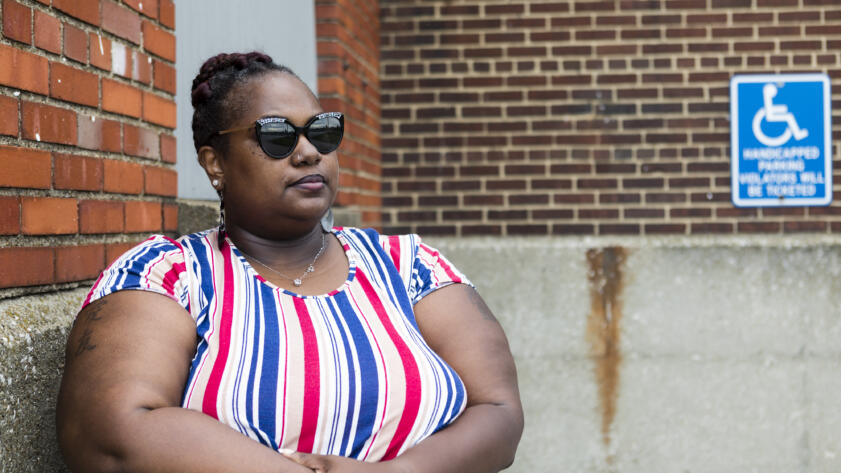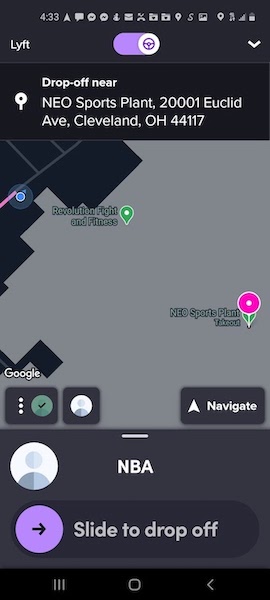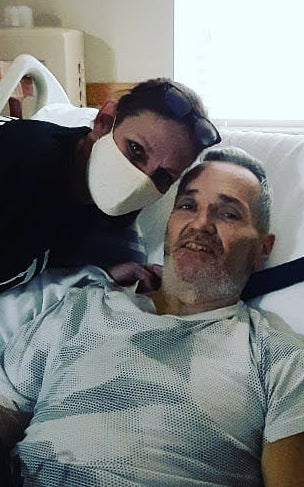As Lyft driver Cynthia Norman steered a white Chevy through Cleveland’s streets on a cold night in January, the app pinged her to pick up a passenger named “NBA.” She pulled up to the curb in front of a two-story brick apartment complex where two men who looked to be in their 20s were waiting for her. One was wearing a gold hoodie, the other was in a black hoodie; both had on face masks.
Norman said she was out late driving because her husband was sick in the hospital and she figured they could use the extra money. After greeting the men, Norman said the one in the black hoodie insisted on sitting in the front seat, despite it being against Lyft’s pandemic rules. That was the first red flag of the night, she said. Next, the Lyft app showed their destination as a short, four-minute ride away—the second red flag. Norman said the third red flag was when the ride ended at a shuttered sports arena.
“Is this where you wanna go? It’s dark,” Norman asked the men, according to a police report.
“Bitch, this is a carjacking, get out,” the man in the passenger seat replied. Then he punched her in the face.
Norman is just one of at least 124 ride-hail and delivery drivers who’ve been carjacked in the U.S. over the last year and a half, according to an analysis by The Markup. Through interviews with drivers and family members, police reports, and local news articles, The Markup found Uber and Lyft drivers from Boston to Nashville to Sioux Falls, S.D., who’ve been victims of carjackings or attempted carjackings. Their cars ended up crashed, in chop-shops, or used in other crimes. Police departments nationwide have reported an overall surge in carjackings during the pandemic, and these incidents appear to be happening to ride-hail drivers at an especially high rate.
Many of the drivers are elderly, immigrants, and women. Eleven have died as a result of the assaults, dozens more have been severely or permanently injured. Some of the carjackings are “wrong place at the wrong time” types of incidents, but 75 (more than 60 percent) of the attacks tracked by The Markup happened after drivers were paired with their would-be assailants by Uber’s or Lyft’s algorithm. The Markup spoke with three drivers who were victims of carjackings, and with friends and family members of two additional drivers. The apps matched all five of those drivers to pick up passengers who then went on to rob, beat, shoot, and in one case, kill them.
See our data here.
Uber and Lyft consider drivers independent contractors, so they don’t have sick leave, workers’ compensation, or medical insurance through the companies. The drivers have little say in who they pick up or where they go, and they’re urged by in-app bonuses and incentives to work long days, often into the night. They can face penalties if they decline rides. While the companies take on little risk employing drivers who provide their own cars and insurance and accrue no benefits, in interviews drivers said they faced property loss, injury, and worse when they placed their lives in the hands of Uber’s and Lyft’s algorithms.
“Lyft and Uber drivers are much more vulnerable than other carjacking victims,” said Eric Piza, an associate professor at John Jay College of Criminal Justice. “If they do this for a living, they have built in reasons to take every ride that comes their way.”
After carjackings, drivers say that when they contacted the companies for help, Uber and Lyft did little to nothing to assist with things like medical bills and property damage. And in many cases the incidents left them without their personal vehicles—which oftentimes can be their primary source of income. Many drivers have started GoFundMe campaigns to get help paying for hospital bills and car replacement or repairs. Families of killed drivers have done the same for funeral arrangements.
“We continuously invest in new products and policies to help protect drivers, and are exploring ways to expand the use of our safety features to help prevent these incidents from happening and support drivers if they do,” said Ashley Adams, a Lyft spokesperson. Jodi Kawada Page, an Uber spokesperson, said, “What’s been reported is extremely concerning … we’ve sent safety information to drivers and couriers and are working with police on their investigations into these horrible crimes.”
Neither company responded to allegations that they failed to help the drivers we spoke to after they were carjacked.
With mounting fear in the gig worker community, some drivers have devised their own workarounds to try and stay safe. In Chicago, for instance, scared drivers have refused to go to certain neighborhoods, which means residents in those areas are seeing high-cost surge pricing and drops in available rides. And in cities across the country, some drivers have bought dash cams, while others say they’ve started carrying weapons despite it being forbidden by the companies.
“We’re not allowed to have any kind of weapon—knives, brass knuckles, pepper spray, guns, baseball bats. But that’s not what we’re seeing now,” said Lenny Sanchez, an Uber and Lyft driver in Chicago and co-founder of the Illinois chapter of driver advocacy group Independent Drivers Guild. “It’s like the Old West—it’s wild.”
Phantom Profiles
Norman is one of those drivers who started carrying a weapon. On the night she picked up NBA, she had a handgun stashed under the armrest of her center console.
After the man in the passenger seat punched her, Norman said, he ran around to the driver’s side to try to pull her out of the car. But she locked the door. At the same time, the man in the back seat grabbed her by the neck and started choking her, yelling, “Get your ass out of the car,” according to the police report. But Norman stayed where she was. After getting hit repeatedly, Norman was finally able to lift the armrest and get her gun.
“I just started shooting,” she said.
As the two men ran off, Norman said she sat there trying to catch her breath and wrap her mind around what had just occurred. She realized it all happened so fast that she still had on her seat belt.
Five days after the ordeal, 19 News reported a female Uber driver in Cleveland was attacked in a nearly identical incident that had the same red flags Norman noted. Two weeks later, it happened again to another Cleveland woman who drove for Lyft. In both cases, the women were reportedly beaten and the carjackers were able to make off with their cars, cellphones, and wallets. The suspects in these cases have yet to be found. Nor have suspects been identified in Norman’s case.
In nearby Columbus, a 73-year-old Lyft driver was attacked in the same way on April 11. She was left battered and bruised, and her 2015 silver Chevy was stolen. According to a police report from the Columbus Division of Police, “The victim pleaded with the suspects asking them why…why…why? The primary suspect responded, ‘You’re the chosen one for the day.’ ”
As with Norman, Lyft’s and Uber’s algorithms paired all three women with their assailants. Neither company responded to requests for comments on these cases.
Driver advocates say Uber and Lyft have not taken simple steps that could have prevented some of the incidents. The companies’ apps make it fairly simple for people to create fake accounts with fake names and, oftentimes, use untraceable payment methods, like a gift card.
Bryant Greening, an attorney and co-founder of Chicago-based LegalRideshare, said he gets calls from drivers who’ve been carjacked on a weekly basis. He said Uber’s and Lyft’s apps are set up in a way that can assist potential carjackers.
“By allowing people to use fake names and not upload pictures of themselves, they give criminals a level of anonymity that makes them feel comfortable committing the crime,” he said.
Drivers have long complained about what they call “phantom profiles,” which are riders, like NBA, who don’t use their real names or profile pictures. Reddit threads are filled with drivers swapping stories about alias rider names like “The man,” “dark vader,” and “KINK86.” A Chicago ride-hail driver started a petition calling on Uber and Lyft to ban fake names because of safety issues; it now has more than 1,800 signatures.
“You wouldn’t believe how many fake names we see almost everyday,” the petition reads. “Suppose you accept this rider request and [the] name is ‘meow meow’ or ‘daddy’ or number ‘8.’ ”
You do background checks on us. Did you do background checks on NBA?
Former Lyft driver Cynthia Norman
To get on the platform, riders just need an email address and phone number—both of which can be spoofed through fake email accounts, free SMS services, and burner phones. For drivers it’s a different story. They must use a government issued ID, go through background checks, and have their name and a photo of themselves in the app.
“They shouldn’t be able to put ‘Pleasure P,’ they should put their government name, plain and simple,” Norman said. “You do background checks on us. Did you do background checks on NBA?”
Both Uber and Lyft have prepaid cards and gift cards available for riders who don’t want to use credit or debit cards. When those untraceable payment methods are linked to accounts with fake names and email addresses, it makes it easy for passengers to be completely anonymous. In April, Uber announced that new accounts using a prepaid card, gift card, or Venmo would also need to upload a valid ID. “These additional verification requirements can act as a deterrent to those who are trying to use the app to cause harm,” Uber said in a blog post.
While the company still allows for alias names, Uber spokesperson Page said it no longer lets riders set up new accounts or change their names using numbers, emojis, or symbols. She added that the company has assisted law enforcement in several carjacking arrests, including two incidents in Chicago. Uber also donated $25,000 to a Crimestoppers fund in Chicago to combat carjackings there. During police investigations, both Uber and Lyft require authorities to submit subpoenas, court orders, search warrants, or emergency disclosure requests for any information on alleged assailants.
In June, Lyft followed Uber’s lead and also stopped allowing new passenger accounts to use untraceable payment methods without additional identification. But that policy is only currently active in Chicago, Atlanta, Los Angeles, and Washington, D.C. Neither Lyft nor Uber responded to questions about whether passengers who already have accounts with anonymous payment methods have to retroactively upload an ID.
Advocates say the companies could do more to keep drivers safe, including banning prepaid cards, requiring all riders to use a valid ID, and having passengers upload selfies before rides.
Lyft didn’t comment on why passengers don’t have to upload profile pictures and are allowed to use alias names and anonymous payment methods. Uber’s Page said it’s optional for riders to upload profile photos, and that for payment methods, “not everyone has access to a bank account or a credit card.” Neither company responded to requests for comment on why they don’t require valid IDs.
“When you remove the ability for potential offenders to remain anonymous, that will often have a crime reduction effect,” said Piza, the John Jay professor. “Not many people would do a certain crime if they have to reveal their identity.”
Flurry of Incidents
Lyft driver Elijah Newman had just moved to St. Louis when he was attacked in an attempted carjacking in April. He was originally from Ghana but had been living in the U.S. since 2011. He had one child in New Jersey and four in Ghana, whom he was working on bringing to the U.S.
“When he moved here, he was just making a new beginning,” said Elizabeth Hylton, his roommate and long-time friend, who created a GoFundMe for Newman’s children. “Elijah, being the person he was, he was not going to give up his car.”
When police arrived at the scene of the incident on April 15, Newman was already dead in the driver’s seat of his car with a gunshot wound to his torso, according to charging documents from the St. Louis Metropolitan Police Department. A probable cause statement obtained by The Markup said a Lyft light was affixed to the front dash and a bullet casing was next to Newman’s body. The alleged assailant had used a fake name to hail the ride, according to the statement.
When police knocked on Hylton’s door late that night, she said she asked them if she needed to go get Newman from the hospital. “They were like, ‘No he’s gone, and we need you to go verify the body,’ ” she said. “It was like a fist to the gut.”
The alleged assailant, who admitted to being at the scene of the shooting, was apprehended by St. Louis police a couple of days later and charged with first degree murder. That case is ongoing.
Newman is one of several ride-hail drivers killed in apparent botched carjackings over the last few months. Others include Uber drivers Javier Ramos and Joe Schelstraete, both of whom were fatally shot in the Chicago area in March and June, respectively; Uber driver Joshua Miller, who was killed in Dallas in January; Timothy Perkins, who also drove for Uber and was fatally stabbed in Detroit in January; and Lyft driver Kristopher Roukey, who was fatally shot in Akron, Ohio, in May. All of these drivers were matched to their attackers by Uber or Lyft’s algorithms.
“He was lured in through the app,” Sanchez, the Chicago driver organizer, said about Schelstraete. “It just crushes me.”
Page, the Uber spokesperson, said, “Regarding the drivers you referred to that lost their lives, we’ve reached out to all of their families to offer our condolences and support.”
Adams of Lyft said, “We are heartbroken by these tragic incidents and have attempted to reach out to these drivers’ families to offer our support. We deactivated the accounts of the riders involved in these incidents the same day they were reported to us.”
Dozens of incidents that don’t involve Uber’s or Lyft’s algorithm have also happened over the last year. Those usually involve people taking advantage of ride-hail drivers who are waiting for a ride or just finishing dropping off passengers. Mohammad Anwar, a Pakistani immigrant and Uber Eats driver was killed in Washington, D.C., in March, after two girls with an electric stun gun approached him while he was parked and then allegedly tried to carjack him.
“Gig workers’ guards are down in a way that normal drivers wouldn’t be because they have strangers getting in and out of their cars,” said Greening, the lawyer. “The nature of gig work requires that drivers have an unlocked vehicle and be stopped on the side of the road … which makes them sitting ducks for a criminal who’s looking to commit this type of crime.”
In many ways, gig workers are the perfect target.
Bryant Greening, LegalRideshare
“In many ways, gig workers are the perfect targets,” he added.
Local news articles tell bait-and-switch stories of passengers asking drivers to put something in the trunk only to have the riders take off with the car. One driver in Washington, D.C., was parked on the side of the road and livestreaming on Facebook when carjackers busted in and stole his vehicle. Other incidents involve Uber Eats or DoorDash delivery drivers dropping off food, only to find their car gone when they return. In at least two of these episodes, the drivers’ children were in the vehicle.
At the time of one of these incidents in San Francisco, DoorDash CEO Tony Xu said in a statement that he was “appalled” and “relieved that the children are safe.” Xu said the company was in contact with the driver and had worked with law enforcement. Campbell Matthews, a DoorDash spokesperson, told The Markup in an email, “We regularly send communications on safety tips and best practices” to workers and the company plans to add an emergency assistance button to its app “later this year.”
While The Markup has tracked more than 100 carjackings of ride-hail drivers over the past year and a half, including three this month in Atlanta, Cleveland, and Key West, this number is far from comprehensive. Not all carjackings are covered by the local news, and most police departments don’t compile stats on carjackings that happen specifically to ride-hail drivers. Not all drivers report the incidents either.
Uber and Lyft didn’t respond to requests to provide data on the number of carjackings involving their drivers.
Sanchez said the Independent Drivers Guild regularly canvasses gig workers at O’Hare airport and encounters about a dozen drivers per week who say they’ve experienced a carjacking or attempted carjacking. Chicago has some of the highest numbers of carjackings nationwide, along with the most known incidents of gig worker carjackings. The Markup tracked at least 44 carjackings of ride-hail drivers within the city’s metro area. For comparison, other metro areas with a high number of gig worker carjackings that we’ve been able to confirm are Atlanta with nine and Cleveland with 12.
“Some [drivers] got in the media, some didn’t. Some of them have bullet holes in their cars, some don’t,” Sanchez said. “These companies have blood on their hands.”
Lyft and Uber didn’t respond to a request for comment on Sanchez’s remark.
Drained Finances
After being carjacked, ride-hail drivers’ lives can be turned upside down as they try to heal from injuries and recover their cars. Last September, Tommy Cross was driving for Lyft when he was attacked by three passengers in Oklahoma City. The night began with him agreeing to sub in for his exhausted wife, who also drove for Lyft and was trying to get in a few more rides by a 5 a.m. deadline to earn a Lyft bonus. It ended with him in critical condition suffering from six bullet wounds.
“When he was picking them up, he said, ‘This isn’t good,’ ” said Sheryl Cross, Tommy’s wife, who was on the phone with him at the time. “He said he felt something right off the bat.”
The specific details of what happened next aren’t fully clear, because Tommy said he went in and out of consciousness. According to an incident report from the Oklahoma City Police Department, police responded to a call reporting him lying in the middle of the road bleeding. He had visible gunshot wounds to his right arm, shoulder, and face. His car was found crashed into a nearby garage with the airbags deployed.
Tommy spent more than a week in the hospital and underwent six surgeries, including the reconstruction of his right shoulder and side of his face. He lost several teeth and some of his tongue, making it difficult for him to speak. His right arm is permanently paralyzed.
“He can’t even tie his shoes,” Sheryl said, verging on tears. “I lost my car, my husband, money, everything we had, for a ride for six dollars and something cents.”
The day after the attack, Sheryl said someone from Lyft called and she yelled at them saying she needed help. That was the last contact she had with anyone from the company, she said. The Crosses’ car was totaled, and even though they had insurance, it didn’t cover the incident because it happened during a Lyft ride. Sheryl said she had no idea they needed separate insurance for that. “It didn’t even cover towing; they billed me for that too,” she said.
Lyft didn’t respond to requests for comment on Tommy’s carjacking and the company’s lack of assistance after the attack. Geico, the Crosses’ insurance provider, didn’t respond to a request for comment.
Two people were apprehended and pleaded guilty last month to charges of armed robbery and the shooting of Tommy. It’s now been nearly 10 months since the incident, and the Crosses still don’t have a car or any type of income. Sheryl said she’d never be a ride-hail driver again but would like to do food deliveries; she set up a PayPal Pool fundraiser to try and get help to buy a new car. “I just want to have a vehicle,” she said, “so we can make some money and work.”
Another Lyft driver, who was carjacked in Chicago in January and wants to remain anonymous for fear of retaliation by his assailants, had a similar experience trying to recoup the costs of his vehicle and belongings. The Markup was able to verify his account through a police news release on the incident.
He was attacked by two passengers, one of whom put a gun to his head before the ride started and demanded he leave the car. When the driver tried to take his backpack with him, the passenger pistol-whipped him. The two passengers then took off with his car, which has not been recovered. No one has been charged in his case.
The driver’s insurance company said that because he was driving for Lyft, his insurance doesn’t cover anything—not his vehicle, cellphone, other items he had in his car, like expensive high-speed phone chargers, or loss of wages. He had separate insurance through Lyft, but it wouldn’t cover anything but the loss of his car, and with that he was still on the hook for a $2,500 deductible.
The driver’s insurance provider didn’t respond to a request for comment. Lyft’s Adams didn’t comment specifically on this instance but said individual claims are reviewed on a case-by-case basis.
“I have to cover my [car] loan. I don’t know how to pay my bills. Even buying food right now for me is challenging,” the driver said. “I don’t know what to do next. It’s a really really tough situation for me. And Lyft has a lot of holes in the system.”
“Right now, I’m broken.”
Lasting Fear
After being attacked at the shuttered sports arena in Cleveland, Norman said she headed straight to the police station. She reported what happened, then the police called an ambulance to take her to the emergency room, where she was treated for cuts, bruises, and an eye injury, which resulted in lasting vision loss. Despite her quick reaction that night, the incident rattled her.
“I just can’t trust no one, period,” Norman said.
Other drivers who spoke with The Markup recounted similar feelings. David Morrow has been an Uber driver in Atlanta for more than three years and has given more than 4,700 trips. But after he was carjacked in February by two men with an assault rifle who stole his 2021 silver Honda Accord, according to an incident report from the Atlanta Police Department, he said he changed his habits.
“I just work the airport,” Morrow said. “People coming in on these flights, they’re not in the business of robbing. They just want to get to their destination.”
He’s also using a rental car through Uber, even though it costs around $300 a week. Morrow’s Honda was recovered but had about $10,000 in damage, and he had to pay the $1,000 insurance deductible. “With this rental car if anything happens, the $1,000 is taken care of,” Morrow said. No one has been charged in his carjacking. Uber didn’t respond to a request for comment on his case.
Sanchez, the Chicago driver organizer, said he’s also seeing drivers work only at the airport now. More gig workers told him they’ve started to carry weapons. And he even came across one driver wearing a bulletproof vest—it’s the only way he feels safe working now, the driver told Sanchez. Sanchez himself quit driving for Uber and Lyft during the pandemic and hasn’t yet returned.
“If it wasn’t for this carjacking crisis I would definitely be out on the road,” Sanchez said. But “I don’t want to die driving.”
Sanchez said it’s crucial that Uber and Lyft do whatever it takes to deter criminals from using the apps. To him, a mandatory selfie feature for passengers would be a good start. He said the photos don’t have to be shared with drivers, but rather the companies could temporarily keep them in their databases in case anything happens during a ride.
Some police departments, like Chicago and Oakland, have issued warnings about carjackings of ride-hail drivers. Advocates say Uber and Lyft could also put those warnings in the apps. Dash cams would additionally be a good deterrent, advocates say. LegalRideshare, the firm Greening co-founded, has donated $10,000 to buy dash cams for Chicago-based drivers.
Lyft didn’t respond to a request for comment about providing drivers with dash cams. Uber’s Page said drivers are free to install their own cameras, so long as they comply with local law.
“It seems like a couple steps could be taken that would solve a lot of problems,” Greening said. “We would like to see these billion-dollar companies come up with solutions, rather than leave it to drivers and small businesses, like myself, to keep everyone safe. They’re the innovators.”
Deactivated
Norman said Lyft dealt her one final blow after her experience with NBA. The day after the carjacking, a company representative named “Bob” called to say Lyft was investigating her account for a “potential violation” of its community guidelines and terms of service. She’d been driving with a gun. She’d worked for Lyft for almost two and a half years, gave 1,636 rides, and had the highest driver rating possible—five stars. She had a license for the gun, according to the police report on the incident.
“The safety of the Lyft community is our highest priority and we take decisions of this nature extremely seriously,” Bob wrote to Norman in a follow-up email, which was provided to The Markup.
Two days later, when Norman looked at her Lyft app, it was overlaid with a message that said, “Your account has been permanently deactivated…. This decision has been reviewed and will remain final.” It appears she was also kicked off the rider app after getting a message there that said, “Your account has been disabled.”
As for NBA, Lyft spokesperson Adams said it let Norman know that “we had taken action,” but Norman said she never heard from Lyft again about whether he’d been deactivated. The company also didn’t offer her any financial assistance for hospital fees, eye doctor visits, or other costs that resulted from being paired with NBA on the app.
Despite everything, Norman said that when she talked to Bob, she told him she had no regrets about carrying the gun.
“If I can’t have a firearm,” she said, “I guess you gonna pay for my funeral.”
Update
This article has been updated to include a response from Uber that came in after press time.










